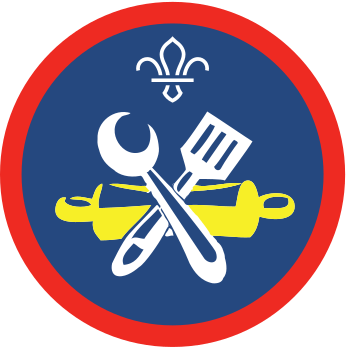
Tasty turkey dinner in a 'tater
You’ll need
- Aluminium foil
- Chopping boards
- Mixing bowls
- Scissors
- Ingredients (see recipe card)
- Sharp knives
- Teaspoons and tablespoons
- Knives and forks
- Access to a campfire or oven
- Heatproof gloves or tongs
- Baking trays
- Buckets of water and/or sand
- First aid kit for burns
- Fire blanket
Bushscout.UK is Programme Support Sub Team. It’s made up of volunteers from all over the UK, who’re passionate about teaching outdoors and practical skills to other Leaders.
Before you begin
- Use the safety checklist to help you plan and risk assess your activity. Additional help to carry out your risk assessment, including examples can be found here. Don’t forget to make sure all young people and adults involved in the activity know how to take part safely.
- Make sure you’ll have enough adult helpers. You may need some parents and carers to help if you’re short on helpers.
Building the fire and preparing to cook
- Build and light a fire before starting this activity. Our activities, Campfire admirers or Construct a campfire, can help you to do this. You’ll use the hot embers to cook on, so the fire will need enough time to die down before cooking.
- Remember to have a hand washing station and take extra hygiene precautions, such as regular handwashing and washing up, when handling raw meat. Take a look at our guidance on food preparation.
- Make sure you have all the ingredients ready. Remember to check your ingredients against any allergy or dietary requirements to ensure everyone can enjoy the recipe. This may mean using alternative ingredients.
- You could do run our fire safety activities, Fuel air ignition and Sitting safely by a campfire, prior to running this session.
Ingredients
You can increase or decrease the number of ingredients used, depending on the size of the groups.
Prep time: 30
Cook time: 60
Serves: 1 or 2
For your turkey ‘tater
- One large potato
- Two tablespoons stuffing mix
- Two tablespoons turkey mince
- Cranberry sauce
For your veg packets
- Leftover potato
- 1 parsnip, sliced
- 1 carrot, sliced
- Olive oil
- Garlic powder, paprika or other spices (optional)
- Salt and pepper (optional)
Prepare your ‘tater
- Wash the potato and carefully cut it in half lengthways, just like you would for a jacket potato.
- Scoop out the inside of the potato halves with a teaspoon and pop the scooped potato in a mixing bowl for later.
- In one half of your potato, add about half your stuffing mix, add your mince on top, then add the rest of your stuffing mix. Separate equipment should be used to handle the mince. This should be washed or put to one side for washing.
- Pop the other half of your potato on top, so the fillings are wrapped inside your potato.
Roast your 'tater
- Wrap your filled potato in thick tin foil to seal it shut. It might be useful to make a ridge, so you can tell which way is up and know where to open your potato later.
- Use heatproof tongs to place your wrapped potato onto the hot embers of a campfire or in a pre-heated oven.
- Roast for 40 to 60 minutes on your campfire embers, or about 60 minutes in the oven. While it’s cooking, you can make a veg packet.
- Remove the potato packets from the heat source, using heatproof gloves or tongs.
- Using the heatproof gloves, carefully open the tin foil and check the fillings are cooked through thoroughly. This should be done by an adult or under adult supervision.
- Once it’s fully cooked, allow the potato to cool slightly, before you serve it with cranberry sauce and tuck in.
Make your veg packet
You could use your leftover potato to make a festive potato packet, with some winter vegetables.
- Using scissors, cut 2 pieces of aluminium foil around 30 cm long.
- If needed, cut any thick pieces of your leftover potato, so they’re about half a centimetre wide.
- Chop all the vegetables, if needed. Be careful when using knives and do this under adult supervision. An adult could also do this in advance of the session.
- Put all the chopped vegetables into a mixing bowl. Add about 1 ½ teaspoons of oil and any spices you’re using.
- Mix all the ingredients together, until everything’s coated with the oil and spices.
- Lay out one of the pieces of foil on a baking tray and place the veg mixture in a pile in the middle.
- Fold the edges of the foil over the mixture, sealing in the goodness, to make a packet.
- Place the packet, with the folded side facing down, onto the second piece of foil. Wrap the packet up again to make sure all the food stays inside.
- Cook the packet over campfire embers, for about 25 minutes, or until the vegetables are nicely cooked.
- Use heatproof gloves or tongs to remove the packet, which should be done by an adult or under adult supervision.
- Allow the packet to cool slightly before you tuck in.
Reflection
What was it like cooking and eating outdoors? How did it feel to be able to make your dish without using any equipment or modern appliances? How does it compare to cooking indoors, using a kitchen?
What skills did people build on in this activity? People may think about things like teamwork, chopping, patience, communication and fire safety. When might they use these skills again?
Safety
All activities must be safely managed. You must complete a thorough risk assessment and take appropriate steps to reduce risk. Use the safety checklist to help you plan and risk assess your activity. Always get approval for the activity, and have suitable supervision and an InTouch process.
- Cooking
Teach young people how to use cooking equipment safely. Supervise them appropriately throughout. Make sure it’s safe to use and follow manufacturers’ guidelines for use.
- Fires and stoves
Make sure anyone using fires and stoves is doing so safely. Check that the equipment and area are suitable and have plenty of ventilation. Follow the gas safety guidance. Have a safe way to extinguish the fire in an emergency.
- Food
Remember to check for allergies, eating problems, fasting or dietary requirements and adjust the recipe as needed. Make sure you’ve suitable areas for storing and preparing food and avoid cross contamination of different foods. Take a look at our guidance on food safety and hygiene.
- Sharp objects
Teach young people how to use sharp objects safely. Supervise them appropriately throughout. Store all sharp objects securely, out of the reach of young people.
There are lots of different jobs that need doing when planning, making and cooking on a campfire. There’s a role for everyone, so encourage everyone to be involved in a way that works for them.
Make sure to check for any dietary requirements or allergies in the group and adjust the recipes accordingly. For a vegetarian option, you could try Quorn mince or sliced Quorn roast. Alternatively, you could make our Sausage, pepper and potato packets with vegetarian sausages.
All Scout activities should be inclusive and accessible.
You could think about what other dishes could be cooked in this way? Or, how you could adapt other festive recipes to cook over a campfire.


